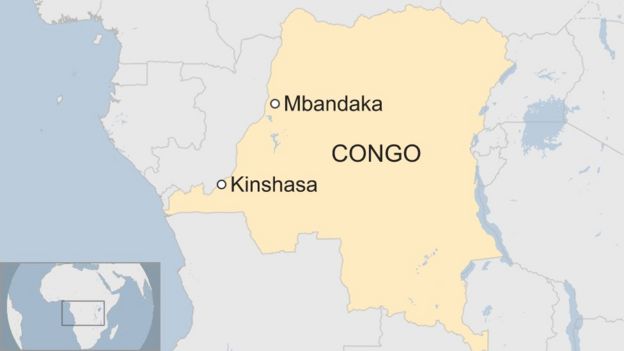The Ebola outbreak in DR Congo has spread from the countryside into a city, prompting fears that the disease will be increasingly hard to control.
Health Minister Oly Ilunga Kalenga confirmed a case in Mbandaka, a city of a million people about 130km (80 miles) from the area where the first cases were confirmed earlier this month.
The city is a major transportation hub with routes to the capital Kinshasa.
Forty-two people have now been infected and 23 people are known to have died.
Ebola is a serious infectious illness that causes internal bleeding and often proves fatal. It can spread rapidly through contact with small amounts of bodily fluid and its early flu-like symptoms are not always obvious.
Why is the spread to a city such a worry?
The 2014-16 West Africa outbreak, which killed 11,300 people, was particularly deadly because it spread to the capital cities of Guinea, Sierra Leone and Liberia.
Senior World Health Organization (WHO) official Peter Salama said the spread to Mbandaka meant there was the potential for an “explosive increase” in cases.
“This is a major development in the outbreak,” he told the BBC. “We have urban Ebola, which is a very different animal from rural Ebola. The potential for an explosive increase in cases is now there.”

Mr Salama, the WHO’s Deputy Director-General of Emergency Preparedness and Response, said Mbandaka’s location on the Congo river, widely used for transportation, raised the prospect of Ebola spreading to surrounding countries such as Congo-Brazzaville and the Central African Republic as well as downstream to Kinshasa, a city of 10 million people.
“This puts a whole different lens on this outbreak and gives us increased urgency to move very quickly into Mbandaka to stop this new first sign of transmission,” he said.
What is being done to contain the outbreak?
Confirmed, probable and suspected cases of Ebola have been recorded in three health zones of Congo’s Equateur province, the WHO said.
Health workers had identified 430 people who may have had contact with the disease and were working to trace more than 4,000 contacts of Ebola patients, who had spread across north-west DR Congo, the organisation said.
Many of these people were in areas only reachable by motorbike, Mr Salama said.
On Wednesday more than 4,000 doses of an experimental vaccine sent by the WHO arrived in the country with another batch expected soon.
The vaccine from pharmaceutical firm Merck is unlicensed but was effective in limited trials during the Ebola outbreak in West Africa.
It needs to be stored at a temperature of between -60 and -80 C. Electricity supplies in Congo are unreliable.
Observers described the international response as “remarkable and very rapid”.
“The logistic issues getting to this very remote area are quite considerable, and it will also be considerable on the ground to identify who should be vaccinated and to get out in this vast and very difficult area and provide vaccination in an appropriate way,” New York-based Ebola expert Dr Laurie Garrett told the BBC.
“It’s never been done before in the midst of an exploding outbreak so we’ll watch it very closely.”
Why does Ebola keep coming back?
There have been three outbreaks in DR Congo since the 2014-16 epidemic. Ebola is thought to be spread over long distances by fruit bats and is often transmitted to humans via contaminated bushmeat.
It can also be introduced into the human population through close contact with the blood, organs or other bodily fluids of infected animals. These can include chimpanzees, gorillas, monkeys, antelope and porcupines.
The disease is endemic to the area and it is not possible to eradicate all the animals who might be a host for Ebola. As long as humans come in contact with them, there is always a possibility that Ebola could return.
Source: BBC


Comments are closed.